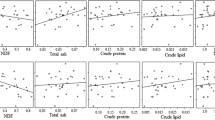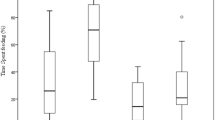Abstract
Leafy spurge (Euphorbia esula) is an introduced forb that is invading western rangelands. Goats (Capra hircus) readily graze the plant, but cattle (Bos tarus) generally and sheep (Ovis aries) locally appear to develop conditioned flavor aversions to leafy spurge. They either avoid the plant entirely or graze it reluctantly. We hypothesized that: (1) a diterpene diester that can occur in leafy spurge was an aversive agent, and (2) diet selection differences among ruminant species may be partly a function of differential ruminai metabolism of aversive phytochemicals, and further that cattle and sheep may be reluctant to graze leafy spurge because their ruminai microbes do not metabolize certain leafy spurge chemicals as do ruminai microbes in goats. Sheep did not develop an aversion to a novel food when its consumption was followed by an intravenous injection of ingenol 3,20-dibenzoate (P=0.34). Sheep did develop an aversion to a novel food when its intake was followed by a dose of leafy spurge fermented with sheep ruminai digesta, but not when followed by a dose of leafy spurge fermented with goat ruminai digesta (P= 0.03). This suggests that goat ruminai microbes may modify leafy spurge such that it does not elicit an aversion in sheep.
Similar content being viewed by others
References
Allison, M.J., Cook, H.M., andDawson, K.A. 1981. Selection of oxalate-degrading bacteria in continuous cultures.J. Anim. Sci. 53:810–816.
Allison, M.J., Hammond, A.C., andJones, R.J. 1990. Detection of ruminai bacteria that degrade toxic dihydroxypyridine compounds produced from mimosine.Appl. Environ. Microbiol. 56:590–594.
Bailey, C.B., andBalch, C.C. 1961. Saliva secretion and its relation to feeding in cattle. 2. The composition and rate of secretion of mixed saliva in the cow during rest.Br. J. Nutr. 15:383–402.
Bartz, S.,Landgraf, B.,Fay, P., andHavstad, K. 1985. Leafy spurge (Euphorbia esula) as a forage component for ewes and lambs.SID Res. Digest Winter: 39–42.
Borison, H.L. 1986. Anatomy and physiology of the chemoreceptor trigger zone and area postrema, pp. 10–17,in C.J. Davis, G.V. Lake-Bakaar, and D.G. Grahame-Smith (eds.). Nausea and Vomiting: Mechanisms and Treatment. Springer-Verlag, New York.
Bosch, F., Rodriquez-Gil, J.E., Hatzolou, M., Gomez-Foix, A.M., andHanson, R.W. 1992. Lithium inhibits hepatic gluconeogenesis and phosphoenolpyruvate carboxykinase gene expression.J. Biol. Chem. 267:2888–2893.
Carlson, J.R., andBreeze, R.G. 1984. Ruminai metabolism of plant toxins with emphasis on indolic compounds.J. Anim. Sci. 58:1040–1049.
Cheng, K.J. 1987. The electron microscopy of bacteria involved in the digestion of forage material by cattle, pp. 114–124,in F.N. Owens (ed.). Symposium Proceedings: Feed Intake by Beef Cattle. Oklahoma Agriculture Experiment Station. MP-121. Stillwater.
Chu, D.T.W., andGranner, D.K. 1986. The effect of phorbol esters and diacylglycerol on expression of the phosphoenolpyruvate carboxykinase (GTP) gene in rat hepatoma H4IIE cells.J. Biol. Chem. 261:16848–16853.
Craig, A.M., Latham, C.J., Blythe, L.L., Schmotzer, W.B., andO'Connor, O.A. 1992. Metabolism of toxic pyrrolizidine alkaloids from tansy ragwort (Senecio jacobaea) in ovine ruminai fluid under anaerobic conditions.Appl. Environ. Microbiol. 58:2730–2736.
Craig, W.M., Broderick, G.A., andRicker, D.B. 1987. Quantitation of microorganisms associated with the paniculate phase of ruminai ingesta.J. Nutr. 117:56–62.
Duncan, A.J., andMilne, J.A. 1992. Rumen microbial degradation of allyl cyanide as a possible explanation for the tolerance of sheep to Brassica-derived glucosinolates.J. Sci. Food Agric. 58:15–19.
Evans, F.J. 1986. Environmental hazards of diterpene esters from plants, pp. 1–31,in F.J. Evans (ed.). Naturally Occurring Phorbol Esters. CRC Press, Boca Raton, Florida.
Forsberg, C.W., andLam, K. 1977. Use of adenosine 5′-triphosphate as a indicator of the microbiota biomass in rumen contents.Appl. Environ. Microbiol. 33:528–533.
Fox, D., Kirby, D., Caton, J., andLym, R. 1991. Chemical composition of alfalfa and leafy spurge at four phenological stages of growth.Proc. N.D. Acad. Sci. 45:46.
Harris, L.E. 1970. Nutritional Research Techniques for Domestic and Wild Ruminants. L.E. Harris Publisher, Logan, Utah.
Hoppe, P.P., Qvortrup, S.A., andWoodford, M.H. 1977. Rumen fermentation and food selection in East African sheep, goats, Thomson's gazelle, Grant's gazelle and impala.J. Agric. Sci. 89:129–135.
Houpt, T.R., andHoupt, K.A. 1968. Transfer of urea nitrogen across the rumen wall.Am. J. Physiol. 214:1296–1303.
Hungate, R.E. 1966. The Rumen and its Microbes. Academic Press, New York.
Huston, J.E., Rector, B.S., Ellis, W.C., andAllen, M.L. 1986. Dynamics of digestion in cattle, sheep, goats and deer.J. Anim. Sci. 62:208–215.
James, L.F., Allison, M.J., andLittledike, E.T. 1975. Production and modification of toxic substances in the rumen, pp. 576–590,in I.W. McDonald and A.C.I. Warner (eds.). Digestion and Metabolism in the Ruminant. University of New England Publishing Unit, Armidale, New South Wales, Australia.
Kosten, T., andContreras, R.J. 1989. Deficits in conditioned heart rate and taste aversion in area-postrema lesioned rats.Behav. Brain Res. 35:9–21.
Kronberg, S.L.,Walker, J.W., andLorenz, R.J. 1992. Differential grazing of leafy spurge by sheep in Idaho and North Dakota, p. 28,in Abstracts, 45th Annual Meeting, Society for Range Management. Spokane, Washington.
Kronberg, SX.,Walker, J.W., andCheney, C.D. 1993a. Learning as a proximate causal mechanism of feeding niche separation in sympatric herbivores.Oecologia Submitted.
Kronberg, S.L., Muntifering, R.B., Ayers, E.L., andMarlow, C.B. 1993b. Cattle avoidance of leafy spurge: A case of conditioned aversion.J. Range Manage. 46:364–366.
Kronberg, S.L.,Walker, J.W., andFitzgerald, J.A. 1993c. Feeding behavior of grazing ruminants experiencing stress.Physiol. Behav. Accepted.
Kupchan, S.M., Uchida, I., Branfman, A.R., Dailey, R.G., Jr., andYuFei, B. 1976. Antileukemic principles isolated from Euphorbiaceae plants.Science 191:571–572.
Lacey, C.A., Kott, R.W., andFay, P.K. 1984. Ranchers control leafy spurge.Rangelands 6:202–204.
Lacey, C.A.,Fay, P.K.,Lym, R.G.,Messersmith, CG.,Maxwell, B., andAlley, H.P. 1985. Leafy spurge: Distribution, biology and control. Montana State University Cooperative Extension Service Circular 309.
Landgraf, B.K., Fay, P.K., andHavstad, K.M. 1984. Utilization of leafy spurge (Euphorbia esula) by sheep.Weed Sci. 32:348–352.
Launchbaugh, K.L., andProvenza, F.D. 1993. How herbivores track variable environments: Response to variability of phytotoxins.J. Chem. Ecol. 19:1045–1054.
Lindroth, R.L. 1988. Adaptations of mammalian herbivores to plant chemical defenses, pp. 415–445,in K.C. Spencer (ed.). Chemical Mediation of Coevolution. Academic Press, New York.
Lym, R.G., andKirby, D.R. 1987. Cattle foraging behavior in leafy spurge (Euphorbia esula)-infested rangeland.Weed Technol. 1:314–318.
Mattes, R.D., Curran, W.J., Jr., Alavi, J., Powlis, W., andWhittington, R. 1992. Clinical implications of learned food aversions in patients with cancer treated with chemotherapy or radiation therapy.Cancer 70:192–200.
Owens, F.N., andGoetsch, A.L. 1988. Ruminai fermentation, pp. 145–171,in D.C. Church (ed.). The Ruminant Animal: Digestive Physiology and Nutrition, Prentice Hall, Englewood Cliffs, New Jersey.
Playne, M.J. 1978. Differences between cattle and sheep in their digestion and relative intake of a mature tropical grass hay.Anim. Feed. Sci. Technol. 3:41–49.
Provenza, F.D., andCincotta, R.P. 1993. Foraging as a self-organizational learning process: accepting adaptability at the expense of predictability, pp. 78–101,in R.N. Hughes (ed.). Diet Selection. Blackwell Scientific Publications, England.
Provenza, F.D., Pfister, J.A., andCheney, C.D. 1992. Mechanisms of learning in diet selection with reference to phytotoxicosis in herbivores.J. Range Manage. 45:36–45.
Reid, R.L., Jung, G.A., Cox-Ganser, J.M., Rybeck, B.F., andTownsend, E.C. 1990. Comparative utilization of warm-and cool-season forages by cattle, sheep and goats.J. Anim. Sci. 68:2986–2994.
Riley, A.L., andTuck, D.L. 1985. Conditioned taste aversions: a bibliography, pp. 381–437,in N.S. Braveman and P. Bronstein (eds.). Experimental Assessment and Clinical Applications of Conditioned Food Aversions. New York Academy of Science, New York.
Russell, J.B. 1984. Factors influencing competition and composition of the rumen bacterial flora, pp. 313–345,in F.M. Gilchrist and R.I. Macke (eds.). Herbivore Nutrition in the Subtropics and Tropics. The Science Press, Johannesburg.
SAS. 1986. SAS system for linear models. SAS Institute, Cary, North Carolina.
Seip, E.H., andHecker, E. 1982. Skin irritant ingenol esters fromEuphorbia esula.J. Med. Plant Res. 46:215–218.
Seynaeve, C., de Mulder, P.H.M., andVerweij, J. 1991. Pathophysiology of cytotoxic drug-induced emesis: Far from crystal-clear.Pharm. Weekbl. Sci. Ed. 13:1–6.
Siebert, B.D., andKennedy, P.M. 1972. The utilization of spear grass (Heteropogon contortus). I. Factors limiting intake and utilization by cattle and sheep.Aust. J. Agric. Res. 23:35–44.
Somers, M. 1961. Factors influencing the secretion of nitrogen in sheep saliva.Aust. J. Exp. Biol. Med. Sci. 39:111–122.
Sorg, B., andHecker, E. 1982. Zur Chemie des Ingenols. II. Ester des Ingenol und des Δ7,8-Isoingenols.Z. Naturforsch. 37b:748–756.
Thornton, R.F. 1970. Urea excretion in ruminants. I. Studies in sheep and cattle offered the same diet.Aust. J. Agric. Res. 21:323–336.
Upadhyay, R.R., Bakhtavar, F., Ghaisarzadeh, M., andTilabi, J. 1978. Cocarcinogenic and irritant factors onEuphorbia esula L. latex.Tumori 64:99–102.
Wachenheim, D.E., Blythe, L.L., andCraig, A.M. 1992. Characterization of rumen bacterial pyrrolizidine alkaloid biotransformation in ruminants of various species.Vet. Hum. Toxicol. 34:513–517.
Walker, J., andKronberg, S. 1992. Preference of leafy spurge by sheep compared to goats, pp. 1–2,in Abstracts, 45th Annual Meeting, Society of Range Management, Spokane, Washington.
Willems, J.L., andLefebvre, R.A. 1986. Peripheral nervous pathways involved in nausea and vomiting, pp. 56–75,in C.J. Davis, G.V. Lake-Bakaar and D.G. Grahame-Smith (eds.). Nausea and Vomiting: Mechanisms and Treatment. Springer-Verlag, New York.
Yokoyama, M.T. andJohnson, K.A. 1988. Microbiology of the rumen and intestine, pp. 125–144,in D.C. Church (ed.). The Ruminant Animal: Digestive Physiology and Nutrition. Prentice Hall, Englewood Cliffs, New Jersey.
Author information
Authors and Affiliations
Additional information
This research was supported in part by a grant from the Cooperative States Research Service (91-38300-6158). All experimental procedures with ruminants followed a protocol approved by the U.S. Sheep Experiment Station's Animal Care and Use Committee. Mention of trade names or companies does not constitute an implied warranty by USDA or the authors.
Rights and permissions
About this article
Cite this article
Kronberg, S.L., Walker, J.W. Ruminal metabolism of leafy spurge in sheep and goats: A potential explanation for differential foraging on spurge by sheep, goats, and cattle. J Chem Ecol 19, 2007–2017 (1993). https://doi.org/10.1007/BF00983803
Received:
Accepted:
Issue Date:
DOI: https://doi.org/10.1007/BF00983803




